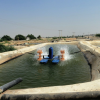Adaptation Options
What are some stormwater management principles for desert regions? The desert southwest of the United States present unique sustainability issues. This implies that stormwater management should also be different.
While the annual rainfall in these areas is less than 10 cm per year, the deserts see incidents of extreme rainfall. As a result, surface runoff is high as is erosion. Thus, the main objective of stormwater management could be to prevent or reduce the movement of sediment, nutrients, pollutants, or debris from land to surface or ground waters. The factors affecting this erosion depend on soil, vegetation, land use, storm and runoff characteristics. Other factors are topography, geology, soil-geomorphology, and the hydrometeorology of the region.
The hydrometeorology characteristics area
- Although the average and annual total precipitation in the Desert Southwest is much lower than in other regions, the extreme value of rainfall depth and intensity can be significan
- The number of days of rainfall in a year is low and thus there is a greater inter-storm duration period
- Urbanization and land development in arid regions have a significant impact through water use, return flow, and flooding
- The evapotranspiration rate is very high.
The rapid urbanization cities like Las Vegas, Tucson, and Phoenix affects the runoff response of watersheds in the Desert Southwest, increasing paved surfaces that prevent infiltration. Green landscaping adds to the management problems, including a rise in the shallow groundwater table and increased pollution loads to receiving waters. As much as 40 percent of water in Tuscon is used for landscaping. These outdoor uses have raised significant concerns for stream water quality. For example, the water table in some parts of the Las Vegas Valley has risen significantly, limiting the natural soil barrier and filtration opportunities. A number of natural washes have been severely eroded. Moreover, increased populations result in increased water use and return flows, which have additional implications such as turning ephemeral channels into perennial streams. The implications for best management practices include
- The size of the storage area needed to treat quality and quantity of water is much smaller
- Since annual depth of rainfall is extremely low, convincing stakeholders of the necessity of such systems (public outreach for non-structural practices) is very challenging
- The high evaporation rate combined with the demands of sustainable water use render common structural practices that are often used in humid regions (e.g. wet detention ponds) unsuitable for the arid regions.
- The increased impervious areas and associated reduced time of concentration caused by rapid urban growth can significantly increase flow rates from the natural condition. This usually increases erosion in the natural washes that are used as flood conveyance facilities.
- The runoff from landscape irrigation and other outdoor uses (nuisance flows) are common. This can impact management that rely on recharge as a treatment mechanism. Moreover, it can have the cumulative effect of turning ephemeral streams into perennial streams, as is evident with the Las Vegas Wash in southern Nevada.
- Pollutant volumes vary from one storm event to the next in the same watershed and depend on the frequency of storms and the number of rainless days between two rainfall events. The build-up of pollutants can increase over longer periods of time, which may result in high concentrations of pollutants in the stormwater during the initial stage of the storm runoff. Given the low frequency of storms in arid regions, pollutant concentrations can be expected to be higher than those in humid regions, particularly the first flush of stormwater. Thus the “first flush concept” is exacerbated in the region, and this concept should be carefully considered while designing BMPs for arid regions
- Management strategies should be based on sustainable land use, water conservation, and water reuse. In the arid Southwest, water is an extremely limited resource. Water demand continues to increase due to rapid urbanization. Based on U.S. Bureau of Census 2001 data, the fastest-growing states in the nation were all located in the West: Nevada (66.3 percent growth), Arizona (40.0 percent), Colorado (30.6 percent), Utah (29.6 percent), and Idaho (28.5 percent). The severity of droughts and potential climate change impacts have further contributed to water scarcity and have clearly put stormwater conservation and water reuse in the forefront of regional priorities for the arid Southwest. Thus, the best strategy for effective BMPs for the arid Southwest would be developed based on stormwater conservation and water reuse. Such conservation practices should be based on rainwater harvesting, local ground water infiltration when feasible, and minimization of evapotranspiration losses.
The following four recurring principles for arid and semi-arid stormwater management provide the guiding factors for stormwater management and BMP design:
- Stormwater practices should be carefully selected, and adapted for arid watersheds
- Stormwater practices should avoid irrigation needs.
- Ground water resources need to be protected from contamination and augmented through recharge practices where feasible.
- Channel erosion and sediment generation in the watershed should be minimized.










Trending Discussions
From around the site...
“Absolutely interested! I'll connect via email to discuss reviewing and enhancing the Economic Analysis of Climate...”
Adaptation-related events at COP28 (all available to follow/stream online)
“Please check out these adaptation-related events taking place at COP28 - all available online (some in person too if...”
Shining a light for biodiversity – four perspectives to the life that sustains us. Four hybrid sessions.
“30 November to 19 December 2023 - Four Sessions Introduction The SDC Cluster Green is happy to invite you to the...”